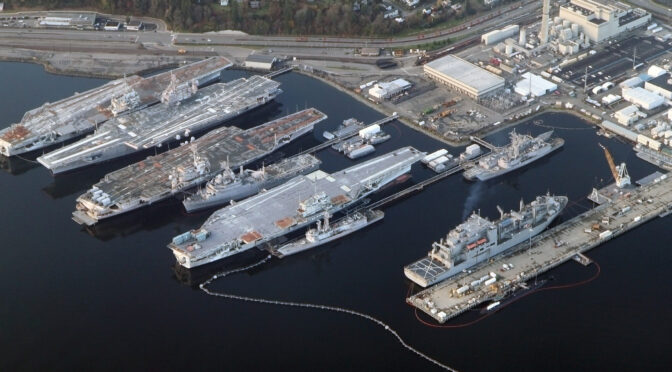By Commanders Andrew “Kramer” Tenbusch and Trevor “Mrs.” Phillips-Levine
Given how 20 to 30 percent of the fleet’s platforms could be replaced by 2045, a thoughtful and imaginative force design process must go beyond measuring the relative importance of existing and planned platforms and capabilities. The Navy needs to divorce itself from its affinity of conceiving capability as a function of traditional naval platforms, such as surface combatants or range-hobbled carrier air wings, and pursue a more holistic concept.
The Navy’s force design should be oriented on the strategic intelligence estimate of the future joint operating environment, the naval enduring functions (missions), and the overlapping required capabilities espoused by the Joint Warfighting Concept. Focusing on the platforms, people (through recruiting, training, and education), and doctrine required to effect operational concepts will allow the Navy to cover its enduring missions and provide needed capabilities. Additionally, the Navy can meaningfully contribute to the Joint Warfighting Concept and effectively defend its budget requests by clearly articulating an integration pathway through the joint force.
The Navy should design its force utilizing hierarchical tiers of sea control. For example, the Navy shall ensure supremacy in the U.S. near seas with the ability to protect the homeland’s approaches to ports and coastline. For the next tier, it shall provide naval superiority in the vital sea lanes that are the economic lifelines to the homeland and her allies. It should also be able to contest the seas where superiority is not possible, but where necessary logistics must transit. Lastly, as the final tier, it can provide sea denial in the areas where an adversary is strongest. These differentiated tiers, overlayed with the future joint operating environment, will demand discrete capabilities that drive a bespoke high-low force mixture. Furthermore, lower-end capabilities provide greater integration opportunities with regional allies and partners, the true strategic center of gravity.
The adage is a ship is a fool to fight a fort. The Navy should avoid the temptation to believe that more ships or traditional platform-centric models of force design will effectively compete with pacing threats, especially when competitors have fielded holistic, land-based networks of capability (forts) oriented toward the maritime domain. Furthermore, the Navy must not repeat the experience of using expensive, high-end systems designed for peer combat in low-level engagements persisting below the level of conflict. To do so, the Navy’s force structure should incorporate more economical platforms for cooperation and competition, preserving the lifespan and readiness of higher-end vessels.
Historically, the Navy pursued a force design independent of the other services, and a force posture the Navy felt was required to win a war within the maritime domain on its own. The practice led to duplications of capability, but the modern defense industrial base does not afford the luxury of excess. Today offers an opportunity for the Navy to change course on force design, which will require strong leadership to redirect the accumulated inertia.
Commander Andrew “Kramer” Tenbusch is a U.S. naval flight officer and prospective executive officer of Strike Fighter Squadron TWO TWO. He recently completed a fellowship with the Halsey Alfa advanced research program at the U.S. Naval War College and is a graduate of the Navy Fighter Weapons School (TOPGUN). CDR Tenbusch is Space Policy and Nuclear Public Policy fellow at Nonproliferation Education Center, and is pursuing a Master’s in Space Systems at the Naval Postgraduate School.
Commander Trevor “Mrs.” Phillips-Levine is a U.S. naval aviator and a special operations joint terminal attack controller instructor. He currently serves as the Joint Close Air Support division officer at the Naval Aviation Warfighting Development Center where he follows unmanned systems employment and tactics. CDR Phillips-Levine is a Nonproliferation Education Center Space and Nuclear Public Policy Fellow, and is pursuing a Master’s in Systems Analysis at the Naval Postgraduate School.
Featured Image: An aerial view of the Puget Sound Naval Shipyard and Intermediate Maintenance Facility in Bremerton, Washington (USA), on 24 November 2012. (Photo via Wikimedia Commons)


If you are interested in this discussion, I strongly recommend this book:
https://www.usni.org/press/books/questioning-carrier
Lots of fleet design thinking, to include new classes of ships…